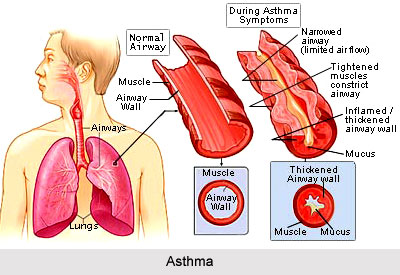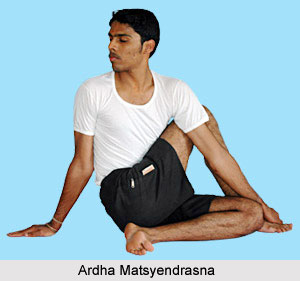It was a prolonged belief that Asthma is a breathing disorder that can never be cured completely. It is primarily a disease of the respiratory system. Here, the patient has more difficulty in expiration than inhalation. The attack of asthma may last for a few minutes to few hours or even days wherein the patient is exhausted. Asthma involves a severe narrowing of the bronchial tubes (bronchi). These tubes originate from the windpipe called the trachea and reaches into the lungs. They carry the oxygen that is breathed in to all parts of the lungs and provide a path for the carbon dioxide to escape up the trachea when the air is breathed out. This narrowing of the bronchi causes difficulty in breathing, specifically when breathing out.
Yoga is a system inclusive of physical and mental training that benefit people of all ages who are suffering from asthma. The healing method of asthma through Yoga, involves Asanas (body postures) and Pranayama (art of breath control). Such methods of treating asthma reduce stress-related conditions. Breathing involves the muscles of the chest wall and the diaphragm. The diaphragm contracts, the muscles of the chest wall pull the chest cavity outward and increases its size. As the size of the chest cavity increases the pressure inside it drops and become less than the atmospheric pressure. This causes air to rush in, to compensate for the difference. Asthma and Bronchitis are two inter related chronic lung ailments that can cause damage to the lungs. These should be treated immediately to avoid further complications.
 The typical attack of Asthma is characterised by a sudden shortness of breath and wheezing, also sometimes accompanied by vigorous coughing. The bringing up of phlegm is not a prominent part of the attack, but if it occurs, the patient may also have the related disease of Bronchitis. Asthma attack is also triggered by infections like common cold and sinusitis, irritants or allergens breathed in like fumes and dust, food allergens, psychological changes, physical effort, and even medicinal drugs. An asthmatic person`s bronchial tubes are supersensitive to various stimuli which persuade constriction and excess mucus is produced in them. This seriously hampers flow of air in and out of the lungs. Mucus enters the narrow bronchial tubes and plugs them up, causing a further decrease in airflow. Identifying the causes and treating the symptoms early, can help prevent attacks and make it worse.
The typical attack of Asthma is characterised by a sudden shortness of breath and wheezing, also sometimes accompanied by vigorous coughing. The bringing up of phlegm is not a prominent part of the attack, but if it occurs, the patient may also have the related disease of Bronchitis. Asthma attack is also triggered by infections like common cold and sinusitis, irritants or allergens breathed in like fumes and dust, food allergens, psychological changes, physical effort, and even medicinal drugs. An asthmatic person`s bronchial tubes are supersensitive to various stimuli which persuade constriction and excess mucus is produced in them. This seriously hampers flow of air in and out of the lungs. Mucus enters the narrow bronchial tubes and plugs them up, causing a further decrease in airflow. Identifying the causes and treating the symptoms early, can help prevent attacks and make it worse.
Asthma may be hereditary. People suffering from this disease are generally allergic to pollen grain, food products, dust, animal hair, drugs, air pollution, industrial smoke and diesel fumes, milk and dairy products. Suppression of negative emotions like jealousy, anger, resentment and hatred are often interpreted as the precipitating causes as well. So also loneliness, emotional hypersensitivity, fear of rejection and super ego are the other precipitating factors. Due to short breath, carbon dioxide is not expelled completely from the body. Constipation and indigestion may be associated with accumulation of toxins leading to asthmatic attack.
Premonitory symptoms of Asthma are usually sneezing, nasal irritation and nose block. Accumulation of mucus in the bronchi gives rise to obstruction in breathing that produces a feeling of burden over chest. Spasm may be present in chest leading to the difficulty in breathing. Patient gasps for breath and nails and lips become blue indicating less oxygen supply. Difficulty in breathing makes patient unable to lie down in the bed and compels the patient to sit in propped up position with support. Exhaustion in breathing leads to sweating. Distress and anxiety increases due to laborious breathing. Eosinophil count in blood increases. Mucus secretion becomes thick and sticky. The chest becomes hyper-expanded and the lungs hyper-inflated. So the person has to do expiration with efforts, which becomes very short. Inspiration is also shallow and short. Longer the struggle for breath more is the severity of the attack, distress and anxiety. The asthmatic is unable to relax. He is exhausted and develops the flexion attitude of the body in a defense.
Yoga asanas, breathing, and relaxation techniques controls the mind of the patient, thus, comforting his emotions, making him more relaxed and allowing him to breathe easier. This will also help the lungs work better and enhance airflow during Asthma attacks. Yoga also purifies the breathing process. Due to airflow obstruction, stale air builds up in lungs, less space for fresh air and in turn less oxygen for the body. Similarly, stale air builds up in lungs, carbon dioxide is not removed from body and toxic level increases.
Kriyas in Yoga is a thorough cleansing process. Jalneti cleans the nasal passage and facilitate free flow of air. Kapalbhati massages the facial muscles and opens tiny outlets on the skin for sweating. Yoga asanas like stretching and contraction during exercises makes lungs and other muscles strong. Pranayama is the deep and rhythmic breathing that multiplies the efficiency of respiratory system. Stress is one of the major factors for asthma. Nispandabhava and savasana helps to reduce the stress level. Yoga helps to develop positive attitude.
 There are some particular Yoga postures that help the patient feel better and take control over Asthma and Bronchitis. However, these exercises should be practiced along with proper medication and the doctor`s recommendation. The seated pose of Sukhasana is one of the classic Meditative Asanas and is usually performed after doing the Corpse Pose. The Easy Pose helps in straightening the spine, slowing down metabolism, promoting inner tranquility, and keeping the mind still, which indirectly keeps the respiratory tracts, remain clear. Shoulder Lifts are the warming up poses of Yoga asana that look into curing the tension in the necks and shoulders, leading to stiffness, bad posture, and tension headaches. Yoga practice can ease Asthma by healing tension, increasing flexibility, and toning the muscles. Twist Yoga Poses like Ardha Matsyendrasana lengthens and strengthens the spine. Besides, the Asthma patients, this asana is also apt for liver, kidneys, as well as adrenal glands.
There are some particular Yoga postures that help the patient feel better and take control over Asthma and Bronchitis. However, these exercises should be practiced along with proper medication and the doctor`s recommendation. The seated pose of Sukhasana is one of the classic Meditative Asanas and is usually performed after doing the Corpse Pose. The Easy Pose helps in straightening the spine, slowing down metabolism, promoting inner tranquility, and keeping the mind still, which indirectly keeps the respiratory tracts, remain clear. Shoulder Lifts are the warming up poses of Yoga asana that look into curing the tension in the necks and shoulders, leading to stiffness, bad posture, and tension headaches. Yoga practice can ease Asthma by healing tension, increasing flexibility, and toning the muscles. Twist Yoga Poses like Ardha Matsyendrasana lengthens and strengthens the spine. Besides, the Asthma patients, this asana is also apt for liver, kidneys, as well as adrenal glands.
Amongst the supine poses of Yoga asana, the wind relieving pose or Pavana Muktasana helps the Asthma patients to eliminate excess gas in the stomach. Pavanamuktasana comes from the Sanskrit word `pavana` which means air or wind and `mukta` which means freedom or release. The Wind Relieving Pose works mainly on the digestive system; however the respiratory system is also benefited. The corpse pose or Savasana is considered as a classic relaxation pose and is practiced before or in between Asanas as well as a final relaxation. While it looks deceptively simple, it is actually difficult to perform. Anuloma-Viloma is a wonderful exercise for the Asthma patients. It is also called the Alternate Nostril Breathing Technique. In this breathing technique, one inhale through one nostril, retain the breath, and exhale through the other nostril. To completely cure asthma, the person has to experience relaxation through physical, mental and spiritual self.
Since Yoga believes that the mind is central to a diseased condition, pacifying and placating it would help cure the disease to a great extent. Asthma sufferers who practice yoga asanas, yogic kriyas, pranayamas, relaxation and meditation all together receive the best benefits of Yoga and thus calms down the whole system. This, in turn, not only helps to reduce the occurrence of Asthma, but also strengthens the lungs, digestive and circulatory system. Over a period of time, that checks attacks and even cures the Asthmatic condition. Yoga asanas that cure asthma have been efficiently executing its function primarily by reducing the levels of anxiety that hardly drugs do without side effects. Yoga gives patients access to their own internal experience and helps them focus the cause of their ailment and find their own triggers. This comes through increased self-awareness. Simple Yogic practices help to regulate breathing patterns, as well as enhance lung functioning. Thus, most patients are able to manage their condition by simply moving away their fears and anxieties.
Practicing Yoga asanas lead to the phase of stabilising the body`s immune system; at this stage asthma is relieved to a great extent. It is now proven that the regular and consistent practice of yoga raises the body`s tolerance to infection as well as its local resistance to infections in the respiratory tract. Yogic rest and relaxation often reduce the nervous system`s overall activity, therefore leading to notable recovery. Only Yoga offers resources like Abhyasa (regular, constant practice) and Vairagya (detachment) as means of holistic healing in regards to Asthma cure as well.
Yoga asanas, such as, Sarvangasana or Viparitakarani, Ardha and purna halasana, Matsyasana, Pavanmuktasana, Bhujangasana, Makarasana, Ardha-shalabhasana, Vakrasana, Parvatasana, Ushtrasana, Gomukhasana, Chakrasana, Tadasana and Shavasana are also recommended to people suffering from this breathing disorder. Practice of Surya-namaskar is also helpful. Besides mudras like Brahmamudra, Simhamudra; bandhas like Uddiyana, Agnisara and the recitation of Om ten times or more can also be helpful.
 For best results, the Asthma patient is always recommended to practice Yoga Asanas, Cleansing Techniques and Pranayama all together. One should lay more emphasis on cleansing modes like Jala Neti and Sutra Neti, Vaman Dhauti and pranayamas like Kapalbhati, Anuloma-Viloma, Ujjayi, Surbyabhedana and Bhramari.
For best results, the Asthma patient is always recommended to practice Yoga Asanas, Cleansing Techniques and Pranayama all together. One should lay more emphasis on cleansing modes like Jala Neti and Sutra Neti, Vaman Dhauti and pranayamas like Kapalbhati, Anuloma-Viloma, Ujjayi, Surbyabhedana and Bhramari.
The general lifestyle that one follows is closely related to the Yoga asanas practiced and greatly depends upon its efficiency. A healthy diet can build the resistance against cold, allergies, and other environmental causes of Asthma, Bronchitis, and other chronic respiratory disorders. It also promotes a strictly non-smoking and non-drinking lifestyle. One should eat easily digestible food. Blowing out candles, blowing balloons and blowing bubbles improve breathing capacity.
DISCLAIMER - The Yoga asanas prescribed above should be strictly performed under the supervision of an experienced Yoga teacher.



